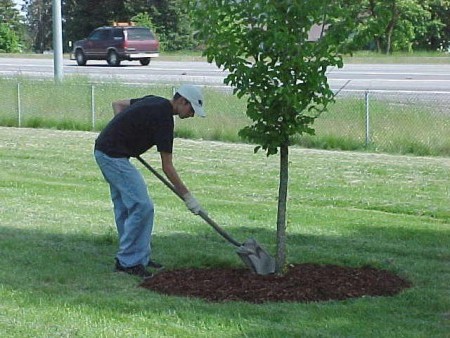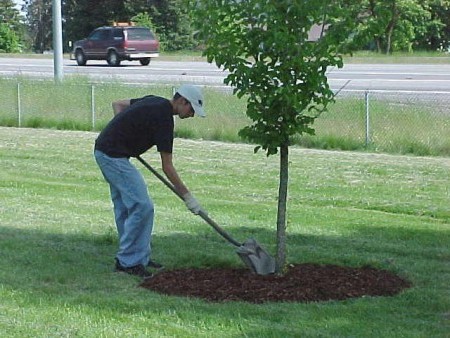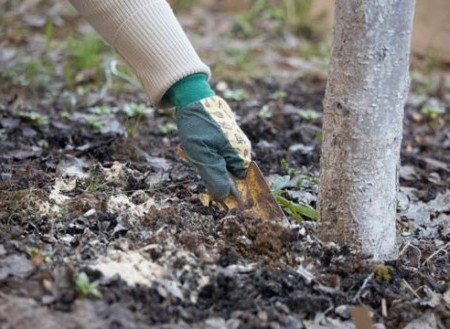Correct and timely processing of the tree trunks of fruit trees is an important part of garden care. During the growing season, the tree trunk circles are kept loose and free from weeds. In the fall, after harvesting, the soil must be dug to a depth of 18-20 cm under apple and pear trees, and 12-15 cm under cherries, sweet cherries, and plums.
Near the trunk, the digging depth is reduced to 5-6 cm.Here are thick skeletal, conductive roots. They should be protected from mechanical damage. Roots as thick as a pencil can withstand injury more easily and are easily restored. Particular care should be taken when digging up the trunk circles of trees on crown rootstocks (columnar, dwarf, semi-dwarf). Their root system is located close to the soil surface and can be damaged when digging.
What to do with leaves
Before digging, fallen leaves should be raked and placed in a compost heap. If they are affected by diseases, burn them.
In cold, snowless winters, leaf litter will help protect the roots from freezing. Therefore, it can be left for the winter under trees, especially columnar ones, and digging can be done at the beginning of leaf fall. In the spring, last year's leaves are removed, because they may contain harmful insects and pathogens.
The circles freed from leaves are loosened to a depth of 5-10 cm with a pitchfork or hoe. In summer, loosening is repeated after watering or rain to break up the soil crust. In August, loosening of tree trunk circles is stopped, because they prevent the ripening of shoots and the preparation of trees for winter.
Autumn processing
In autumn in tree trunk circles apply organic fertilizers: manure and phosphorus-potassium. Depending on the age of the tree - from 0.5 to 4 buckets per tree. Organic once every 2-3 years, on poor soils - annually.
Together with organic fertilizers, mineral fertilizers are added - superphosphate and potassium sulfate (potassium sulfate). It is better to place them in the area where the bulk of the suction roots are located, to a depth of 30-40 cm. It is better to place them in holes or grooves along the periphery of the crown.
If mineral and organic fertilizers are applied separately (by year), their dose is increased by 1.5-2 times.
On soils with poor physical properties (clayey - sandy), organic matter is added annually at a dose of 2-3 kg per square meter. m, on poorly cultivated soils - 1.5 times more.
The doses of mineral fertilizers also depend on the age of the tree: phosphorus 15-80 g, potassium fertilizers - from 15 to 100 g per tree on moderately cultivated soils. For stone fruits, the dose is reduced by 1.5 times.
Nitrogen fertilizers in the fall apply only 1/3 of the annual norm: 5-20 g per tree. They are needed for nutrition and root growth.





 (5 ratings, average: 3,80 out of 5)
(5 ratings, average: 3,80 out of 5) CUCUMBERS NEVER GET SICK, I'VE BEEN USING ONLY THIS FOR 40 YEARS! I SHARE A SECRET WITH YOU, CUCUMBERS ARE LIKE THE PICTURE!
CUCUMBERS NEVER GET SICK, I'VE BEEN USING ONLY THIS FOR 40 YEARS! I SHARE A SECRET WITH YOU, CUCUMBERS ARE LIKE THE PICTURE! You can dig a bucket of potatoes from each bush. Do you think these are fairy tales? Watch the video
You can dig a bucket of potatoes from each bush. Do you think these are fairy tales? Watch the video
 How our fellow gardeners work in Korea. There is a lot to learn and just fun to watch.
How our fellow gardeners work in Korea. There is a lot to learn and just fun to watch. Eye trainer. The author claims that with daily viewing, vision is restored. They don't charge money for views.
Eye trainer. The author claims that with daily viewing, vision is restored. They don't charge money for views. A 3-ingredient cake recipe in 30 minutes is better than Napoleon. Simple and very tasty.
A 3-ingredient cake recipe in 30 minutes is better than Napoleon. Simple and very tasty. Therapeutic exercises for cervical osteochondrosis. A complete set of exercises.
Therapeutic exercises for cervical osteochondrosis. A complete set of exercises. Which indoor plants match your zodiac sign?
Which indoor plants match your zodiac sign? What about them? Excursion to German dachas.
What about them? Excursion to German dachas.